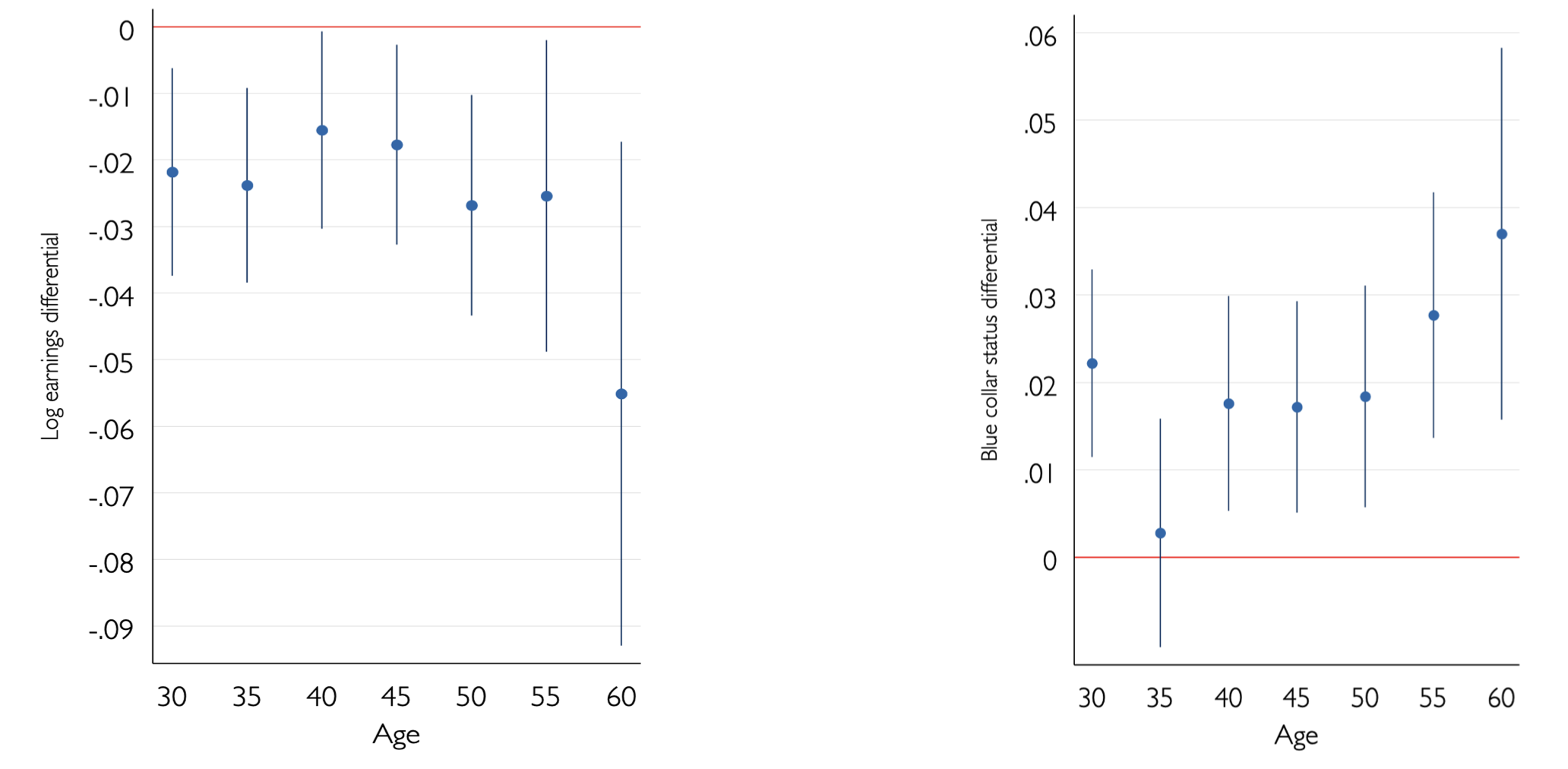According to recent estimates, between 50% and 85% of the population in developed countries experiences a potentially traumatic event (PTE) during their lifetime. These events can include being involved in a severe accident, losing a partner, being the victim of a crime, or witnessing acts of extreme violence or terror (Benjet et al. 2016, de Vries and Olff 2009, Kessler and Wang 2008). PTEs pose significant threats to psycho-physical wellbeing, and their adverse effects extend to the next generation. Previous work (Almond and Currie 2012, Black et al. 2016, Kuzawa and Quinn 2009, Persson and Rossin-Slater 2018) has demonstrated that a mother’s exposure to traumatic events during pregnancy compromises the health and human capital of her children. However, not much is known about the effect of traumatic and stressful experiences on the next generation’s labour outcomes over their lifecycle . We examine how a traumatic event experienced by a pregnant mother shapes the evolution of the working career of her offspring from the start of their career to retirement.
Wars produce the most significant negative effects on human and physical capital, leading to disrupted production processes and heightened uncertainty (Almond and Currie 2010, Voth et al. 2020, Akbulut-Yuksel 2022, Ekamper et al. 2022, Koczan and Chupilkin 2022). We exploit a specific situation in Italy during WWII – the Armistice on 8 September 1943, when Italy ceased hostilities against the Allied forces. In response to the treaty, German forces occupied Italy and performed violent raids to spread fear and terror. The raids were intentionally unpredictable and idiosyncratically distributed. Although there were relatively few casualties, and the raids lasted only a few days, they were characterised by intense violence that caused great stress and trauma to those who lived through them. These acts of extreme violence against civilians in wars and civil conflicts remain tragically relevant, as the Ukraine crisis demonstrates. 1
We exploit the unexpected outbreak of the raids – and the municipal and monthly variation – after controlling for the intensity of the war as well as local time-invariant and time-varying characteristics, identifying the average causal effect of prenatal exposure to a PTE over and above other adversities related to war.
We build a unique dataset combining three primary data sources. The ‘Atlas of Nazi and Fascist Massacres’ lists all raids that occurred in Italy after 8 September 1943. We link this to an administrative individual employer-employee matched dataset provided by the VisitINPS scholars programme that covers the universe of Italian private-sector workers between 1974 and 2018. We focus on male cohorts born around 8 September 1943. The data contain detailed working histories and information on wage earnings, occupation, employment status, educational attainment, pensions, and disability and unemployment benefits. The third source of information is the archive of WWII conflicts in Italy from Statistics Italy (ISTAT 1957). This dataset includes granular details on the number of victims of armed conflicts between Allied Forces and Germans by province and month.
Results
Results of generalised difference-in-differences (DID) models show that prenatal exposure to a PTE reduces earnings by about 2% at the start of one’s labour market career (Figure 1). The earnings penalty gradually increases along one’s career to about 6% at retirement. Moreover, we find that the lower earnings can be attributed to lower educational attainment and occupation sorting: those prenatally exposed to a Nazi raid are more likely to sort into low-skilled blue-collar jobs. We also find that the exposed are more likely to experience unemployment, causing the earnings penalty to increase as people age.
Figure 1 Effect of Nazi raids on log earnings and blue-collar status


However, other confounding issues could be responsible for these results. For example, it could be that the earnings penalty increases because the exposed suffer more from job losses later in life. To shed light on this hypothesis, we exploit the matched worker-firm information and examine the effect of job loss due to a firm mass layoff. 2 Estimates of a triple-DID model show that later-life job loss disproportionally affects the exposed. In particular, job loss negatively impacts all workers’ next year’s earnings by 31–34%, but for the prenatally exposed, the earnings penalty can increase up to 47%. Moreover, mass layoff episodes are likely to increase mortality, but this effect is independent of in-utero exposure to a Nazi raid.
While prenatal exposure to a Nazi raid is substantial, no effects are found for exposure in the first and second years of life. This result is relevant as the raids may have caused lasting psychological trauma – post-traumatic stress disorder (PTSD) – affecting parental health behaviours and parenting skills. Also, the raids may have led to property destruction and persistent income losses. Should these alternative mechanisms be relevant, they would harm both the prenatally exposed and those exposed in their first years of life. Thus, our results are driven by in-utero exposure to a raid and not by behavioural and/or income effects post-birth. A series of robustness checks confirm our results, and we show that selective fertility, mobility, and mortality do not bias our estimates.
Possible mechanisms
As a further step in our analysis, we argue that maternal stress triggered by the traumatic event is likely the most critical mechanism driving our empirical findings. Several medical studies show that a mother’s hormonal response to stress increases maternal glucocorticoids. This has a profound impact on the neurological development of the foetus, leading to cognitive and mental problems as well as increased vulnerability to stress (Boersma and Tamashiro 2014, Cotter and Pariante 2002, Marmot et al. 1991, Van den Bergh et al. 2005, Weinstock 2005). 3
In support of our interpretation and in line with this literature, we find lower educational attainment among the exposed. A mediation analysis shows that a large share (42%) of the total treatment effect on wage earnings can be explained by the impact of the treatment on education. Additionally, we use a medical database on health expenditures and find that prenatal exposure to a Nazi raid has significant and sizeable effects on health expenditures, but only for diseases of the nervous system and mental disorders, conditions typically associated with prenatal stress. We also show that the effects of a Nazi raid do not include the effects of hunger, changes in maternal health, maternal health behaviours, or reduced family income.
Conclusion
Traumatic and stressful events may play an important role in the persistence of low socio-economic status across generations (Aizer et al. 2016). Analysing the adverse and extremely violent events of the Nazi raids that occurred in Italy at the end of WWII confirms that these effects can last over one’s entire labour market career, significantly shaping lifetime earnings and the capacity to react to further adverse events in adulthood. Public programmes targeted at (pregnant) women and children can effectively mitigate the adverse effects of a bad start and the consequences of adversity later in life. The resurgence of a violent and long-lasting war in the western world puts these issues again at the centre of socio-economic debate.
This blog post is based on data from the recently published Voxeu.





